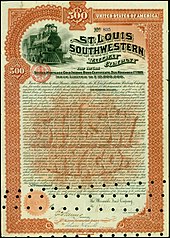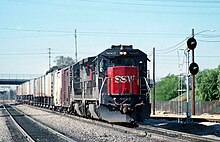St. Louis Southwestern Railway
This article has multiple issues. Please help improve it or discuss these issues on the talk page. (Learn how and when to remove these messages)
|
 | |
 Cotton Belt system as of 1918 | |
| Overview | |
|---|---|
| Headquarters | St. Louis |
| Reporting mark | SSW |
| Locale | Arkansas, Illinois, Kansas, Louisiana, Missouri, New Mexico, Oklahoma, Tennessee and Texas |
| Dates of operation | 1891–1992 |
| Successor | Southern Pacific Railroad Union Pacific Railroad |
| Technical | |
| Track gauge | 4 ft 8+1⁄2 in (1,435 mm) standard gauge |
The St. Louis Southwestern Railway Company (reporting mark SSW), known by its nickname of "The Cotton Belt Route" or simply "Cotton Belt", was a Class I railroad that operated between St. Louis, Missouri, and various points in the U.S. states of Arkansas, Tennessee, Louisiana, and Texas from 1891 to 1980, when the system added the Rock Island's Golden State Route and operations in Kansas, Oklahoma, and New Mexico. The Cotton Belt operated as a Southern Pacific subsidiary from 1932 until 1992, when its operation was assumed by Southern Pacific Transportation Company.
Corporate history
[edit]
The Cotton Belt was part of the railroad empire acquired by financier Jay Gould in the last quarter of the 19th century. "By 1890 Gould owned the Missouri Pacific, the Texas and Pacific, the St. Louis Southwestern, and the International-Great Northern, one-half of the mileage in the Southwest", the Handbook of Texas wrote.[1]
The railroad was organized on January 15, 1891, although it had its origins in a line founded in Tyler, Texas, in 1871. Construction of the original Tyler Tap Railroad began in the summer of 1875, and the first 21 miles out of Tyler to Big Sandy, Texas were constructed by early October 1887.[2][3] The line became the Texas and St. Louis Railway, and was completed between Gatesville, Texas and Bird's Point, Missouri by August 12, 1883, creating a continuous 725-mile system.[2] However, that line promptly went into receivership, and was purchased by the St. Louis, Arkansas and Texas Railway in 1886.[4][5] The assets of that company were acquired out of foreclosure by the St. Louis-Southwestern Railway in 1891.[4]
On October 18, 1903, the Cotton Belt gained trackage rights over the Missouri Pacific Railroad along the eastern shore of the Mississippi River to reach East St. Louis, Illinois, and then used Terminal Railroad Association trackage rights into St. Louis. The Cotton Belt operated a freight station in downtown St. Louis, but its main base of operations in the area was its yard and a locomotive servicing facility in East St. Louis, just east of Valley Junction, and south of Alton and Southern Railroad's Gateway Yard, and north of Kansas City Southern's East St. Louis Yard. Union Pacific Railroad now operates Cotton Belt Yard, although the engine servicing facilities have been demolished.

The Cotton Belt and its subsidiary St. Louis Southwestern Railway of Texas operated 1,607 miles of road in 1945; 1,555 miles in 1965; and 2,115 miles in 1981 after taking over the Rock Island's Golden State Route. In 1925, SSW and SSW of Texas reported a total of 1,474 million net ton-miles of revenue freight and 75 million passenger-miles; in 1970 it carried 8,650 million ton-miles and no passengers.
The Southern Pacific Railroad (SP) assumed control of the SSW on April 14, 1932[6] and operated it as a subsidiary of SP until 1992, when the Southern Pacific consolidated the Cotton Belt's operations into the parent company.[7] Southern Pacific merged with Union Pacific Railroad in 1996.[6]

Passenger service
[edit]The Cotton Belt ran passenger trains from St. Louis to Texas and from Memphis to Dallas and Shreveport, Louisiana. Cotton Belt's Lone Star operated from Memphis Union Station to Dallas Union Terminal with a connecting section from Lewisville, Arkansas, to Shreveport. The Morning Star was the second named train over much of this route, operating out of St. Louis Union Station to Dallas, with a separate Memphis section inaugurated in 1941 to provide a convenient connection with the Southern Railway's Tennessean to and from Washington, D.C., and New York City. The Cotton Belt also operated passenger trains between Mt. Pleasant, Tyler and Waco, and a doodlebug between Tyler and Lufkin.
The Cotton Belt began a series of passenger train cutbacks in the early 1950s. The railroad had 25 steam engines and four gas-electric motor cars available for passenger service in 1949. By late 1952 nine diesels had replaced the steam locomotives and motorcars and passenger train mileage had been trimmed considerably. The final operations in Texas involved overnight service between St. Louis and Dallas, with major intermediate stops in Jonesboro, Pine Bluff, Texarkana and Tyler.[8] The Cotton Belt was one of the first Class 1 lines in the southwest to discontinue passenger service. The last Cotton Belt passenger train, #8, operated on November 30, 1959, from Pine Bluff, Arkansas, to East St. Louis, Illinois.
Acquisitions
[edit]The following railroads were acquired or merged into the Cotton Belt Route:
- Blytheville, Leachville & Arkansas Southern Railroad - Basically an industrial line bringing timber to the Chicago Mill & Lumber Company near Blytheville AR. Operated 17 miles of owned track from a logging location known as Shaw AR to Leachville AR, from there had running rights 8 miles over the Frisco to Arbyrd, MO, from thereto had running rights over the Paragould Southeastern Railway for 22 miles to Chickasawba AR, then ran on 2.5 miles of owned track to the mill.[9]
- Gideon & North Island Railroad
- Little River Valley & Arkansas Railroad
- Paragould Southeastern Railway - Incorporated October 11, 1887 as a tramway, it was reorganized as a standard gauge line in 1893 and by 1907 the line ran from Paragould, Arkansas to Blytheville, Arkansas. The St. Louis & Southwestern Railroad fully absorbed the line in January 1914.[10][11]
- St. Louis, Arkansas & Texas Railway
- Stuttgart & Arkansas River Railroad
- Texas & St. Louis Railway

Notable employees
[edit]- Louisiana politician Andrew R. Johnson (1856–1933) was once a depot agent for the Cotton Belt railroad.[12]
- Railroad official Robert Krebs worked for Cotton Belt in the late 1960s and early 1970s as a trainmaster and terminal superintendent. Krebs became superintendent of the Cotton Belt at age 29.[when?]
See also
[edit]
References
[edit]- ^ Vivian, Julia L. "Jay Gould". Handbook of Texas Online. Texas State Historical Association. Retrieved 4 April 2015.
- ^ a b "St. Louis Southwestern Railway, "The Cotton Belt Route"". American-Rails, June 12, 2023. Retrieved October 8, 2023.
- ^ "Texas and St. Louis Railway". Texas State Historical Association. Retrieved October 8, 2023.
- ^ a b "St. Louis Southwestern Railroad History". Arkansas Railroad Museum. Retrieved October 5, 2023.
- ^ "St. Louis, Arkansas and Texas Railway". Texas State Historical Association. Retrieved October 9, 2023.
- ^ a b "Union Pacific merger family tree | Trains Magazine". TrainsMag.com. June 2, 2006. Archived from the original on 2020-07-22. Retrieved 2020-07-22.
- ^ Solomon, Brian (2014-10-21). North American Railroads: The Illustrated Encyclopedia. Voyageur Press. ISBN 978-0-7603-4736-2.
- ^ "St. Louis Southwestern Railway, Table 1". Official Guide of the Railways. 88 (4). National Railway Publication Company. September 1955.
- ^ ""Tap Line Case" Summary of Blytheville, Leachville & Arkansas Southern Railroad". Texas Transportation Archive. Retrieved September 6, 2024.
- ^ Strouse, L.K. (1929). Interstate Commerce Commission Reports: Reports and Decisions of the Interstate Commerce Commission of the United States. Vol. 149.
- ^ "Paragould Southeastern Railway". arkansasrailroadmuseum.org. Retrieved 2024-01-13.
- ^ "Mike Miller, "Andrew R. Johnson," from Henry E. Chambers, A History of Louisiana, Vol. II, Chicago and New York City, 1925, pp. 147-148". usgarchives.rog. Archived from the original on March 16, 2012. Retrieved May 25, 2010.
External links
[edit]- St. Louis Southwestern Railway from the Handbook of Texas Online
- Cotton Belt Depot Museum (Tyler, Texas)
- Facts on the Cotton Belt 4-8-4's, Including the 819
- Cotton Belt website
- Cotton Belt Rail Historical Society
- Cotton Belt Railroad Symposium, annual event hosted by Texas A&M University-Commerce
Bibliography
[edit]- Moody's Steam Railroads, 1949.
- Moody's Transportation Manual, 1968.
- Goen, Steve Allen. Cotton Belt Color Pictorial, Four Ways West Publications, 1999, ISBN 1-885614-25-X.
- Eighty Years of Transportation Progress: A History of the St. Louis Southwestern Railway (Cotton Belt Public Relations Department, 1957) as published in the October 1957 issue of The Cotton Belt News.
- St. Louis Southwestern Railway
- Predecessors of the Southern Pacific Transportation Company
- Defunct Arkansas railroads
- Defunct Missouri railroads
- Defunct Texas railroads
- Defunct Illinois railroads
- Former Class I railroads in the United States
- Companies based in St. Louis
- Railway companies established in 1891
- Railway companies disestablished in 1992
- Defunct Tennessee railroads
- Defunct New Mexico railroads
- Defunct Louisiana railroads
- Defunct Kansas railroads
- Defunct Oklahoma railroads
- 1891 establishments in the United States
- 1992 disestablishments in the United States
